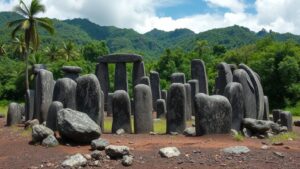Exploring submerged temples in the Gulf of Thailand tied to the Khmer Empire.
Exploring Submerged Temples in the Gulf of Thailand Tied to the Khmer Empire
The Gulf of Thailand, a region rich in history and culture, harbors remnants of the magnificent Khmer Empire, which flourished from the 9th to the 15th centuries. Beneath the waves lie submerged temples, providing a glimpse into a civilization renowned for its remarkable architecture and advanced engineering. This article explores these underwater relics, their historical significance, and the ongoing efforts to study and preserve them.
The Khmer Empire: An Overview
The Khmer Empire was one of the most significant empires in Southeast Asia, reaching its zenith between the 11th and 13th centuries. Predominantly located in present-day Cambodia, it extended its influence to regions in Thailand and Laos. The empire is best known for its stunning temple complexes, most famously Angkor Wat, constructed in the early 12th century.
During its height, the Khmer Empire engaged in extensive trade and cultural exchanges, which led to the establishment of major ports along the Gulf of Thailand. As a result, many temples and structures were created, some of which have since succumbed to the forces of nature.
The Submerged Temples of the Gulf of Thailand
The Gulf of Thailand is home to several submerged temples, remnants of the Khmer civilization that flourished in the area. Many of these structures were likely built as spiritual and trading hubs that contributed to the empires prosperity. Over time, rising sea levels, coastal erosion, and tectonic shifts submerged these ancient sites.
- Wat Larn Saka: Located off the coast of the province of Prachuap Khiri Khan, this submerged temple was discovered in the late 20th century. Archaeologists have noted that the temples intricate sandstone carvings and foundations lie approximately 15 meters underwater, offering insight into Khmer architectural techniques.
- Wat Khao Sam Roi Yot: This site, submerged near the national park of the same name, has yielded artifacts such as ceramics and religious sculptures, indicating its historical significance as a trade center. Exploration of this site demonstrates the fusion of artistic styles reminiscent of both Khmer and local influences.
The Importance of Underwater Archaeology
Underwater archaeology plays a crucial role in understanding the history of submerged structures. The examination of underwater sites can reveal information about the social, political, and economic aspects of the Khmer Empire. Through systematic research and advanced technologies, underwater archaeologists have been able to uncover artifacts and architectural features that tell the story of this once-great civilization.
For example, innovative methods such as sonar mapping and remotely operated vehicles (ROVs) help researchers locate hidden structures and assess their condition. By studying these temples, experts can draw connections to other historic locations within the empire and understand the broader implications of climate change and human activity on these cultural sites.
Challenges and Preservation Efforts
Preserving submerged temples poses significant challenges. Environmental factors, such as rising sea levels and increased salinity, threaten the integrity of these sites. The impact of tourism, illegal fishing, and other human activities can also compromise the preservation efforts.
Organizations focused on maritime heritage are working to address these issues. Examples of preservation initiatives include:
- Collaboration with local communities to monitor and protect submerged sites from illegal activities.
- Awareness campaigns to educate tourists and locals about the historical significance of these submerged temples.
- Research grants and international partnerships to fund archaeological studies aimed at uncovering and documenting these underwater treasures.
Conclusion and Actionable Takeaways
The submerged temples in the Gulf of Thailand serve not only as fascinating archaeological sites but also as reminders of the rich cultural heritage left by the Khmer Empire. Through dedicated underwater archaeological efforts, we can preserve these structures for future generations to explore and appreciate. Visitors to the region can contribute by:
- Participating in eco-friendly tourism activities that promote historical awareness.
- Supporting local initiatives focused on preserving underwater heritage.
- Engaging with educational programs that enhance understanding of the Khmer Empires impact on Southeast Asian history.
In summary, exploring the submerged temples of the Gulf of Thailand provides an invaluable opportunity to connect with history while fostering respect for the environment and cultural heritage.



